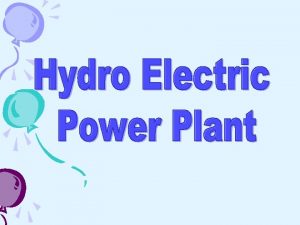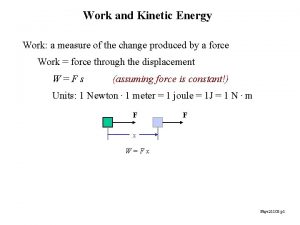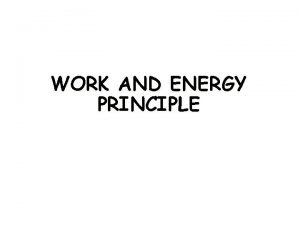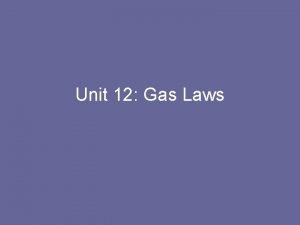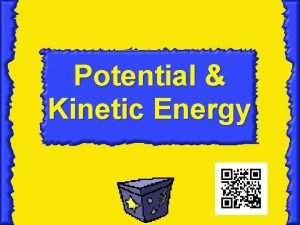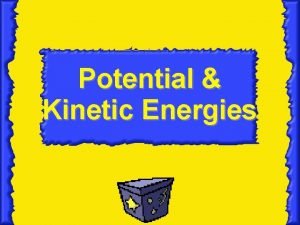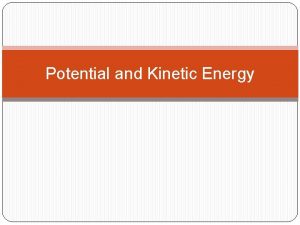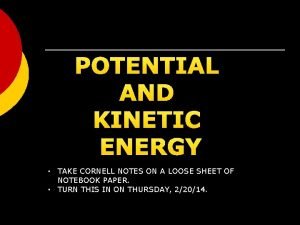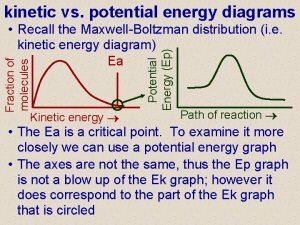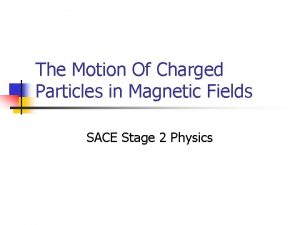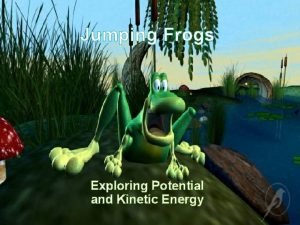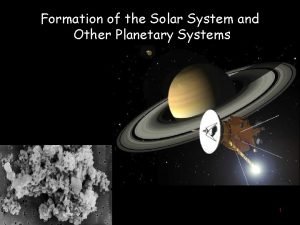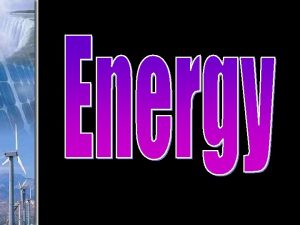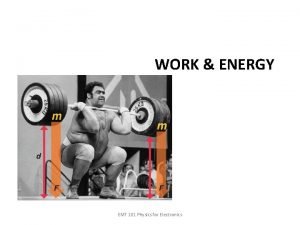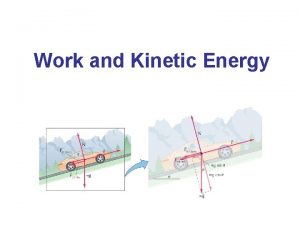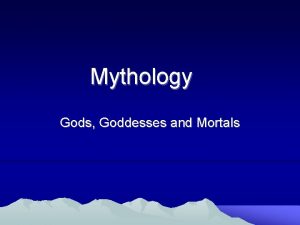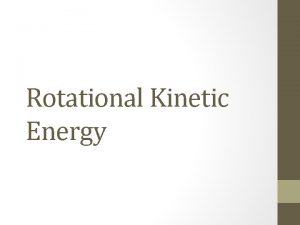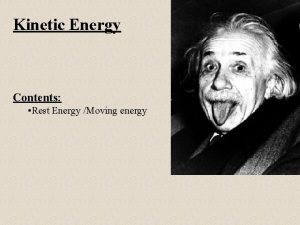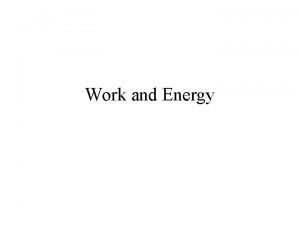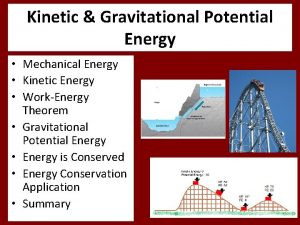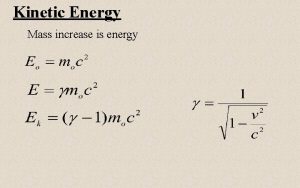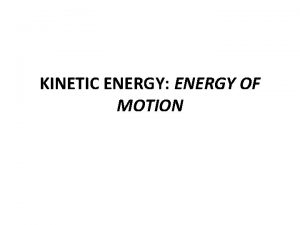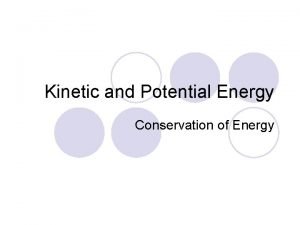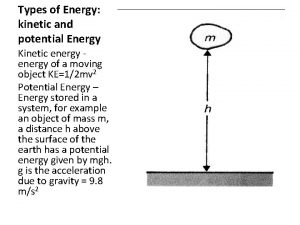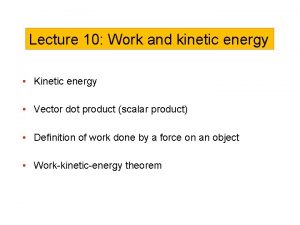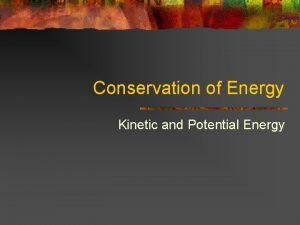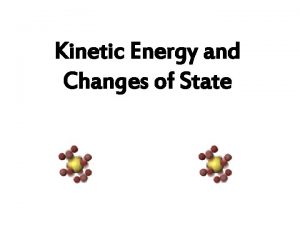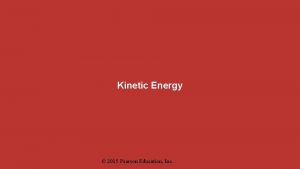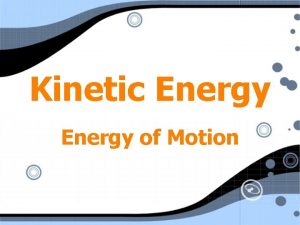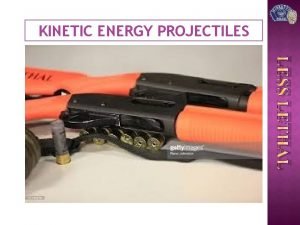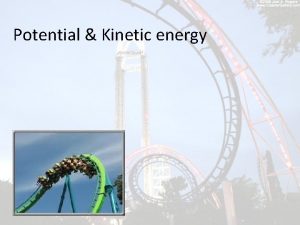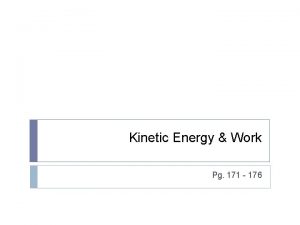Energy and Power Kinetic Energy Greek for moving








































- Slides: 40

Energy and Power

Kinetic Energy Greek for “moving” Kinetic energy is the energy of motion. An object which has motion - whether it be vertical or horizontal motion - has kinetic energy. There are many forms of kinetic energy - vibrational (the energy due to vibrational motion), rotational (the energy due to rotational motion), and translational (the energy due to motion from one location to another). To keep matters simple, we will focus upon translational kinetic energy.

kinetic energy will refer to translational kinetic energy which an object has depends upon two variables: the mass (m) of the object and the speed (v) of the object. The following equation is used to represent the kinetic energy (KE) of an object. M = Mass V = Velocity Kinetic energy is measured in joules http: //www. britannica. com/coasters/ride. html

Example: An automobile is traveling down the highway at 10 meters/second and has a mass of 1000 Kg what is its kinetic energy that this time and place. The two variables in this equation are velocity and mass, so if either one changes so does the amount of kinetic energy. Potential Energy Potential energy can be thought of as energy stored within a physical system. This energy can be released or converted into other forms of energy, including kinetic energy. It is called potential energy because it has the potential to change the states of objects in the system when the energy is released.

The elastic potential energy is defined as having energy stored when compressed or expanded in an elastic body. The potential energy of a string or spring stretched.

Gravitation potential energy an object has is equal to the work done to lift it. Work = force X Distance. Gravitational potential energy = Mass X Gravitational acceleration X Height

Different Forms of Energy Mechanical Energy either potential or kinetic, but in relation to the objects motion or position. Thermal Energy Thermal energy is the energy portion of a system that increases with its temperature. Molecules of a substance will vibrate or agitate when energy is infused within the material. Example: Water will boil when enough energy is infused into a beaker containing the water. The molecules bounce off of each other so violently that they eventual become water vapor or steam.

Chemical Energy Chemical energy is a potential energy with the energy stored in the chemical bonds. An example of this is the food we eat provide the energy to run, breath, grow, and think. The chemical bonds of the complex foods we eat are broken down releasing the energy stored in the bonds and allowing our body to transfer the energy to be use in other stated ways. Electrical Energy Electrical energy is the flow of electrical charge or electrons.

Electromagnetic (EM) radiation is a self-propagating wave in space with electric and magnetic components. These components oscillate at right angles to each other and to the direction of propagation, and are in phase with each other. Electromagnetic radiation is classified into types according to the frequency of the wave: these types include, in order of increasing frequency, radio waves, microwaves, infrared radiation, visible light, ultraviolet radiation, X-rays and gamma rays.


Nuclear Energy Nuclear fission is the splitting of the nucleus of an atom into parts (lighter nuclei) often producing photons (in the form of gamma rays), free neutrons and other subatomic particles as by-products. Fission of heavy elements is an exothermic reaction which can release large amounts of energy both as electromagnetic radiation and as kinetic energy of the fragments (heating the bulk material where fission takes place). Fission is a form of elemental transmutation because the resulting fragments are not the same element as the original atom.


Nuclear Fission

Nuclear Fusion Nuclear fusion is the process by which multiple atomic particles join together to form a heavier nucleus. It is accompanied by the release or absorption of energy. Iron and nickel nuclei have the largest binding energies per nucleon of all nuclei and therefore are the most stable. The fusion of two nuclei lighter than iron or nickel generally releases energy while the fusion of nuclei heavier than iron or nickel absorbs energy; vice-versa for the reverse process, nuclear fission

Hydrogen Bomb The Sun

Review Potential Energy Potential energy is energy that is in a stored form. It isn't being used at the moment, but is waiting to do work. Think about a boulder sitting on top of a hill. Just sitting there, the boulder isn't doing anything. But because it is sitting on top of a hill, it has the potential to roll down and do some damage to a car or building below. The energy is stored in that rock because of its size (mass) and the distance it will travel once it starts rolling. Kinetic Energy Kinetic energy is energy that is in motion. This energy is performing work. Legs are pumping bicycle pedals. Coal is running generators. Lightning is snapping trees.

Potential or Kinetic Energy?

Then this must be ?

Conservation of Energy is neither created or destroyed but only changes form (transforms). All of the energy that goes into a system is constant. In other words, energy may be converted from one form to another, but it doesn't just disappear or multiply. For example, let's say we are going to turn natural gas into electricity. We want to look where the energy goes during the process of turning it into electricity. 1. The natural gas is burned, creating heat energy. 2. The heat energy is used to turn water into steam. 3. The steam turns a turbine generator. This changes the heat energy into mechanical energy. Finally, the mechanical energy used by the generator makes electrical energy

We only wanted one type of energy — electricity. But the process can't turn natural gas directly into electricity. Energy was used during the process. We lost energy as extra heat, friction (created by the turbine), and products of combustion (smoke, carbon dioxide, water). In the end, the natural gas that is combusted is equal to all of the other forms of energy that it was transformed into. The Sun, the center of our solar system. It gives off heat, light, and radiation. The sun is actually a ball of glowing gases. It is hotter than anything we can imagine. It is so hot that we can feel its heat even though we are 93 million miles away from it. If you could look inside the sun, you would see four different layers: the core, the radiative zone, the convective zone, and the photosphere.

Steam Turbine that would turn a generator to produce electricity

Solar Energy The Sun, the center of our solar system. It gives off heat, light, and radiation. The sun is actually a ball of glowing gases. It is hotter than anything we can imagine. It is so hot that we can feel its heat even though we are 93 million miles away from it. If you could look inside the sun, you would see four different layers: the core, the radiative zone, the convective zone, and the photosphere.

Producing Energy (Fusion) The sun produces heat, light, and radiation through the process of fusion. Fusion occurs when a substance is so hot that atoms gain and lose particles, actually changing from one type of element to another. The sun converts hydrogen to helium. We mere humans can not synthesize energy directly for the Sun. We must use other means to get the necessary energy indirectly from the Sun. A relatively new way is converting solar energy directly into electricity. By using a photovoltaic cell humans can convert or transform sunlight directly into electricity. http: //www. pbs. org/wgbh/nova/solar/inside. html

How many Nuclear power plants are there in the US and where are they? Why hasn’t the US built a nuclear power plant in the last 20 years? What are the pros and cons or good and bad of nuclear power? http: //www. pbs. org/newshour/bb/environment/energy/nuclear_plants. html

How Nuclear Power Works Nuclear power plants provide about 17 percent of the world's electricity. Some countries depend more on nuclear power for electricity than others. In France, for instance, about 75 percent of the electricity is generated from nuclear power, according to the International Atomic Energy Agency. In the United States, nuclear power supplies about 15 percent of the electricity overall, but some states get more power from nuclear plants than others. There are more than 400 nuclear power plants around the world, with more than 100 in the United States.

To build a nuclear reactor, what you need is some mildly enriched uranium. Typically, the uranium is formed into pellets with approximately the same diameter as a dime and a length of an inch or so. The pellets are arranged into long rods, and the rods are collected together into bundles. The bundles are then typically submerged in water inside a pressure vessel. The water acts as a coolant. In order for the reactor to work, the bundle, submerged in water, must be slightly supercritical. That means that, left to its own devices, the uranium would eventually overheat and melt.

To prevent this, control rods made of a material that absorbs neutrons are inserted into the bundle using a mechanism that can raise or lower the control rods. Raising and lowering the control rods allow operators to control the rate of the nuclear reaction. When an operator wants the uranium core to produce more heat, the rods are raised out of the uranium bundle. To create less heat, the rods are lowered into the uranium bundle. The rods can also be lowered completely into the uranium bundle to shut the reactor down in the case of an accident or to change the fuel. http: //science. howstuffworks. com/nuclear-power 2. htm

The uranium bundle acts as an extremely high-energy source of heat. It heats the water and turns it to steam. The steam drives a steam turbine, which spins a generator to produce power. In some reactors, the steam from the reactor goes through a secondary, intermediate heat exchanger to convert another loop of water to steam, which drives the turbine. The advantage to this design is that the radioactive water/steam never contacts the turbine. Also, in some reactors, the coolant fluid in contact with the reactor core is gas (carbon dioxide) or liquid metal (sodium, potassium); these types of reactors allow the core to be operated at higher temperatures

Unfortunately, there are significant problems with nuclear power plants: Mining and purifying uranium has not, historically, been a very clean process. Improperly functioning nuclear power plants can create big problems. The Chernobyl disaster is a good recent example. Chernobyl was poorly designed and improperly operated, but it dramatically shows the worst-case scenario. Chernobyl scattered tons of radioactive dust into the atmosphere. Spent fuel from nuclear power plants is toxic for centuries, and, as yet, there is no safe, permanent storage facility for it. Transporting nuclear fuel to and from plants poses some risk, although to date, the safety record in the United States has been good.

On April 26, 1986, a major accident, determined to have been a reactivity (power increase) accident, occurred at Unit 4 of the nuclear power station at Chernobyl, Ukraine, in the former USSR. The accident destroyed the reactor and released massive amounts of radioactivity into the environment. After the accident, access to the area in an 18 -mile radius around the plant was closed, except for persons requiring official access to the plant and to the immediate area for evaluating and dealing with the consequences of the accident and operation of the undamaged units. Approximately 135, 000 people were evacuated


Pripyat, the town near Chernobyl where most of the plant workers lived before the 1986 accident, was evacuated several days after the accident because of radiological contamination. It was included in the 30 km exclusion zone around the plant and is closed to all but those with authorized access.

Fossil Fuels When mentioning fossil fuels, what do we think of? Rocks with imprints of ancient animals or petrified trees. Fossil Fuels are substances that contain hydrocarbons. The hydrocarbon fuels we use to heat our home, run our automobiles, produce our electricity, and cook on our BBQ grills comes in the form of petroleum oil, natural gas, and coal. Coal is theorized to have been created by the ancient forest some 400 million years ago during the carboniferous period. Where as, oil has been thought to be ancient zooplankton and algae.

Coal is a hard, black colored rock-like substance. It is made up of carbon, hydrogen, oxygen, nitrogen and varying amounts of sulphur. There are three main types of coal - anthracite, bituminous and lignite. Anthracite coal is the hardest and has more carbon, which gives it a higher energy content. Lignite is the softest and is low in carbon but high in hydrogen and oxygen content. Bituminous is in between. Today, the precursor to coal - peat - is still found in many countries and is also used as an energy source

Coal is found in many of the lower 48 states of U. S. and throughout the rest of the world. Coal is mined out of the ground using various methods. Some coal mines are dug by sinking vertical or horizontal shafts deep under ground, and coal miners travel by elevators or trains deep under ground to dig the coal. Other coal is mined in strip mines where huge steam shovels strip away the top layers above the coal. The layers are then restored after the coal is taken away.

Oil or Petroleum Oil is another fossil fuel. It was also formed more than 300 million years ago. Some scientists say that tiny diatoms are the source of oil. Diatoms are sea creatures the size of a pin head. They do one thing just like plants; they can convert sunlight directly into stored energy. In the graphic on the left, as the diatoms died they fell to the sea floor (1). Here they were buried under sediment and other rock (2). The rock squeezed the diatoms and the energy in their bodies could not escape. The carbon eventually turned into oil under great pressure and heat. As the earth changed and moved and folded, pockets where oil and natural gas can be found were formed (3).

Oil has been used for more than 5, 000 -6, 000 years. The ancient Sumerians, Assyrians and Babylonians used crude oil and asphalt ("pitch") collected from large seeps at Tuttul (modernday Hit) on the Euphrates River. A seep is a place on the ground where the oil leaks up from below ground. The ancient Egyptians, used liquid oil as a medicine for wounds, and oil has been used in lamps to provide light.


Natural Gas Sometime between 6, 000 to 2, 000 years BCE (Before the Common Era), the first discoveries of natural gas seeps were made in Iran. Many early writers described the natural petroleum seeps in the Middle East, especially in the Baku region of what is now Azerbaijan. The gas seeps, probably first ignited by lightning, provided the fuel for the "eternal fires" of the fire-worshiping religion of the ancient Persians. http: //encarta. msn. com/encnet/features/mapcenter/map. aspx Natural gas is lighter than air. Natural gas is mostly made up of a gas called methane. Methane is a simple chemical compound that is made up of carbon and hydrogen atoms. It's chemical formula is CH 4 - one atom of carbon along with four atoms hydrogen. This gas is highly flammable. http: //www. chemicalelements. com/

In physics, power (symbol: P) is the rate at which work is performed or energy is transmitted, or the amount of energy required or expended for a given unit of time. As a rate of change of work done or the energy of a subsystem, power is: where P is power W is work t is time. Power = work divided by time Work in Joules Time in seconds Power equals work per second or watts
 Example of kinetic energy
Example of kinetic energy Potential energy of spring
Potential energy of spring Gravitational potential energy
Gravitational potential energy The change in mechanical energy
The change in mechanical energy Site:slidetodoc.com
Site:slidetodoc.com What is gravitational kinetic energy
What is gravitational kinetic energy Gravitational potential energy vs kinetic energy
Gravitational potential energy vs kinetic energy Kinetic energy to thermal energy
Kinetic energy to thermal energy Kinetic energy vs potential energy
Kinetic energy vs potential energy Power triangle
Power triangle Kinetic power plant
Kinetic power plant Moving power which impels one to act
Moving power which impels one to act Acceleration and kinetic energy
Acceleration and kinetic energy Principle of work and kinetic energy
Principle of work and kinetic energy Relation between pressure and kinetic energy of gas
Relation between pressure and kinetic energy of gas Kinetic and potential energy
Kinetic and potential energy Graphic organizer about kinetic energy
Graphic organizer about kinetic energy Kinetic and potential energy
Kinetic and potential energy Potential and kinetic energy roller coaster
Potential and kinetic energy roller coaster Potential energy
Potential energy Potential and kinetic energy diagram
Potential and kinetic energy diagram Lesson 2 kinetic and potential energy answer key
Lesson 2 kinetic and potential energy answer key Kinetic energy in magnetic field
Kinetic energy in magnetic field Energy systems grade 7
Energy systems grade 7 Energy frog
Energy frog Which statement best compares momentum and kinetic energy?
Which statement best compares momentum and kinetic energy? Whats the difference between kinetic and potential energy
Whats the difference between kinetic and potential energy When is mechanical energy conserved
When is mechanical energy conserved What is energy in physics
What is energy in physics Work done and kinetic energy
Work done and kinetic energy What is the greek miracle in greek mythology
What is the greek miracle in greek mythology Kontinuitetshantering i praktiken
Kontinuitetshantering i praktiken Typiska drag för en novell
Typiska drag för en novell Tack för att ni lyssnade bild
Tack för att ni lyssnade bild Returpilarna
Returpilarna Varför kallas perioden 1918-1939 för mellankrigstiden
Varför kallas perioden 1918-1939 för mellankrigstiden En lathund för arbete med kontinuitetshantering
En lathund för arbete med kontinuitetshantering Personalliggare bygg undantag
Personalliggare bygg undantag Vilotidsbok
Vilotidsbok Anatomi organ reproduksi
Anatomi organ reproduksi Förklara densitet för barn
Förklara densitet för barn










